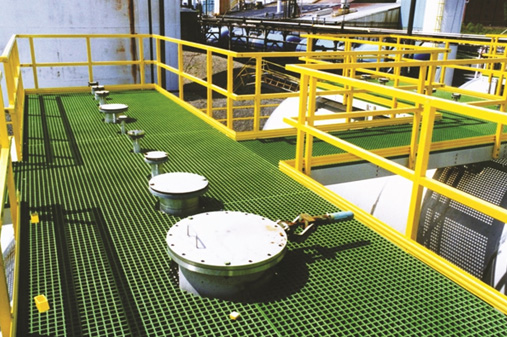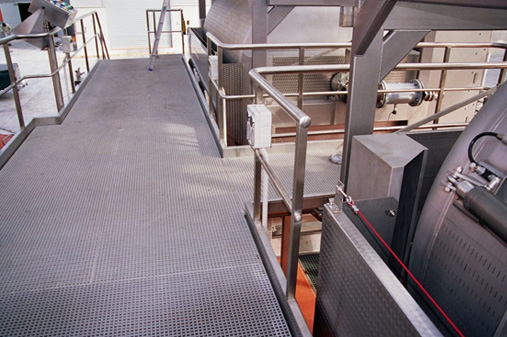Grating
FRP grating is made by combining fibreglass and resin. The fibreglass gives the finished product its strength, while the resin makes it resistant to corrosive substances.
FRP grating is usually found in hazardous or harsh environments where it may be subject to the elements or come into contact with dangerous and corrosive chemicals. Here are some examples of situations where FRP grating is used:
1. On ships and offshore installations: the tough, durable nature of FRP grating makes it ideal for ships and oil rigs or other offshore installations. It can be exposed to wind, rain and extremes of temperature and it can be submerged in water. It is also lightweight and relatively easy to transport.
2. Working with flammable materials: FRP grating doesn’t give off any sparks, so it is often seen as a safer alternative to steel or other metals around flammable materials. For example, dropping metal objects on it would not create sparks, potentially causing atmospheric gases around it to ignite.
3. In electrically hazardous environments: FRP grating is often used in electrically hazardous environments because it is non-conductive. It therefore reduces the risk of electric shock or other injuries in the event of an accident involving electricity.
4. In chemical plants: FRP grating is non-corrosive. This can make it the ideal material for walkways, platforms and other surfaces in chemical plants where there is a risk of corrosive materials leaking or being spilled.
5. On complex construction sites: the ease of transporting, storing and cutting FRP grating makes it a flexible and cost-effective solution for site work. Construction firms are able to use standard cutting
tools to make FRP grating fit complicated and fluid site layouts.
FRP grating has a number of benefits, some of which we covered in the previous section. Here are the main reasons it is chosen over metal and other grating alternatives:
1. Durable: FRP grating is able to withstand harsh environments for extended periods of time without being damaged or degraded. It is low maintenance and easy to clean. And the moulded-through colour means it won’t need to be repainted.
2. Fire resistant: while specific fire ratings will depend on the individual product, generally speaking FRP grating offers a high level of resistance to heat and fire.
3. Flexible: it is easily cut to fit particular flooring layouts and can be adjusted as layouts change, which reduces waste and saves on extra costs.
4. Lightweight: FRP grating is easier to transport and store than other grating alternatives, which reduces costs and avoids stoppages and delays to projects.
5. Non-conductive: it doesn’t conduct electricity, so it is safer in electrically hazardous environments.

